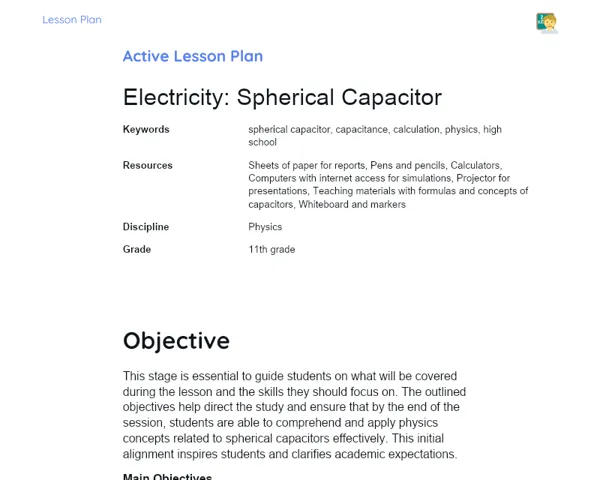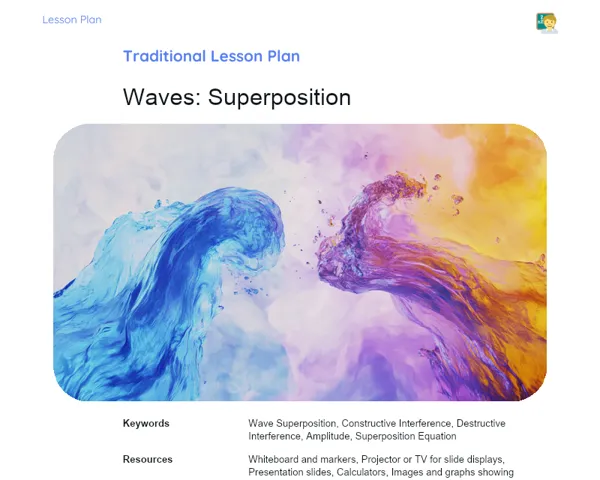Lesson Plan | Lesson Plan Tradisional | Kinematics: Reference Frame and Position
| Keywords | Reference Frame, Position, Kinematics, Coordinate System, Inertial Reference Frame, Non-Inertial Reference Frame, Cartesian Coordinates, Motion, Practical Example, Space Navigation |
| Resources | Whiteboard, Markers, Projector, Presentation Slides, Paper Sheets, Pens, Physics Textbook, Computer or Tablet, Laser Pointer, Ruler or Measuring Tape |
Objectives
Duration: (10 - 15 minutes)
The aim of this part of the lesson plan is to introduce the essential concepts of reference frames and position, which are foundational for studying kinematics. By clearly stating the main objectives, students will understand what is expected of them and how these concepts relate to motion. This stage sets the stage for the detailed explanations and examples that will be provided during the lesson, ensuring students are on the same page with the learning objectives.
Objectives Utama:
1. Understand that a reference frame is a system used to describe the motion of an object, which can be stationary or moving.
2. Learn to identify and describe the position of an object in a given reference frame.
Introduction
Duration: (10 - 15 minutes)
The purpose of this section of the lesson plan is to establish a solid groundwork for students to appreciate the role of reference frames in studying kinematics. By incorporating relatable examples and intriguing facts, the objective is to engage students and promote their understanding of fundamental concepts related to reference frames and position. This introduction prepares students for the more in-depth explanations to come, ensuring they have a clear starting point for the lesson.
Did you know?
Did you know that the concept of a reference frame is also crucial in space navigation? 🚀 Engineers at NASA must select a particular reference frame to accurately calculate the path of a spacecraft to ensure it reaches the intended destination. Without the right reference frame, determining the position and movement of the spacecraft would be nearly impossible.
Contextualization
To kick off the lesson on kinematics, it's important for students to grasp that the study of motion is closely tied to the concept of a reference frame. Imagine you’re at a railway station and a train begins to move. To someone onboard, it appears as if the station is pulling away. Conversely, to someone at the station, it’s the train that’s moving. This simple illustration underscores the significance of reference frames in describing the motion of an object. Reference frames are coordinate systems we utilize to explain where and how something moves.
Concepts
Duration: (50 - 60 minutes)
The goal of this section of the lesson plan is to deepen students' understanding of the concepts of reference frame and position. Through exploring specific topics and working through tailored questions, students will reinforce their theoretical knowledge and practice its application in real-world scenarios. This approach enhances comprehension of essential kinematics concepts and prepares students for advanced studies in the future.
Relevant Topics
1. Concept of Reference Frame: Explain that a reference frame is a coordinate system used to describe the position and motion of an object. Emphasize that it can either be stationary or in motion.
2. Inertial and Non-Inertial Reference Frames: Explain the distinction between inertial frames (that are not accelerating) and non-inertial frames (that are accelerating). Use everyday examples to clarify these ideas.
3. Position in a Reference Frame: Teach how to ascertain the position of an object within a reference frame. Explain the application of coordinates (x, y, z) and how they help in specifying the position of a point in space.
4. Cartesian Coordinate System: Introduce the three-dimensional Cartesian coordinate system, explaining its use in describing an object's position in three dimensions (length, breadth, and height).
5. Practical Example: Use a relatable practical example to demonstrate the concepts of reference frame and position. For instance, the position of a car on a straight road can be illustrated using a one-dimensional coordinate system.
To Reinforce Learning
1. Define what a reference frame is and clarify the difference between an inertial and a non-inertial reference frame.
2. In a three-dimensional Cartesian coordinate system, how would you outline the position of a point in space? Provide an example.
3. Think about a moving train. Explain how one could describe the position of a passenger inside the train using a reference frame that is at rest at the station.
Feedback
Duration: (15 - 20 minutes)
The objective of this part of the lesson plan is to revisit and reinforce the concepts discussed earlier, ensuring students have a grasp of the topics covered. Engaging in question discussions and reflections allows students to articulate their thoughts and clarify doubts. This is a vital moment to identify potential gaps in understanding and solidify their acquired knowledge.
Diskusi Concepts
1. Define what a reference frame is and explain the difference between an inertial and a non-inertial reference frame: A reference frame is a coordinate system that describes the position and motion of an object. An inertial reference frame is one that is not accelerating, allowing Newton's laws to apply without fictitious forces. A non-inertial reference frame is accelerating, necessitating the consideration of fictitious forces to accurately describe object motion. 2. In a three-dimensional Cartesian coordinate system, how would you describe the position of a point in space? Give an example: In a three-dimensional Cartesian coordinate system, a point's position is given by three coordinates (x, y, z), each representing a distance from an origin point along one of the three mutually perpendicular axes. For instance, point A could be positioned at (3, 4, 5), where 3 is the distance along the x-axis, 4 along the y-axis, and 5 along the z-axis. 3. Consider a moving train. Explain how the position of a passenger inside the train can be defined using a reference frame that is at rest at the station: The position of a passenger inside the train can be described based on their distance from a reference point within the train, like the front of the carriage. Yet, when assessing a reference frame stationary at the station, we must consider both the position of the train relative to the station and the passenger's location inside it. For example, if the train is 100 meters from the station, and the passenger is 5 meters from the front of the carriage, the total position of the passenger would be the sum of these measurements.
Engaging Students
1. How would you explain the difference between an inertial and a non-inertial reference frame in your own words? 2. Why is it crucial to select the correct reference frame when discussing the motion of an object? 3. How does the choice of reference frame alter the interpretation of an object's movement? 4. Share an example of a non-inertial reference frame you experience in your daily life and explain why it is deemed non-inertial. 5. If you're in a car that's speeding up, how would you explain your position and movement in relation to a static reference frame on the road?
Conclusion
Duration: (10 - 15 minutes)
The aim of this concluding part of the lesson plan is to review and consolidate the concepts discussed, confirming students' comprehension of the topics. This moment is pivotal for reinforcing acquired knowledge, bridging theory with practice, and emphasizing the subject's importance to students' everyday experiences.
Summary
['Reference frames are coordinate systems employed to describe the position and motion of an object.', 'There are inertial reference frames (not accelerating) and non-inertial frames (accelerating).', 'The position of an object can be assessed using coordinates (x, y, z) within a reference system.', "The three-dimensional Cartesian coordinate system is utilized for describing an object's position across three dimensions.", 'Hands-on examples illustrate the practical application of reference frames and position concepts.']
Connection
The lesson successfully linked theory with practical applications by using everyday examples and real scenarios to depict the concepts of reference frames and position. This facilitated students' ability to visualize how these principles can be applied in various situations, from the motion of a train to navigation systems in space.
Theme Relevance
The significance of the topic is evident in day-to-day life, as understanding reference frames is vital for describing and analyzing motion in numerous contexts, such as traffic situations, sports, and even space exploration. The curiosity around employing reference frames in space travel showcased the intriguing relevance of the learned material.



